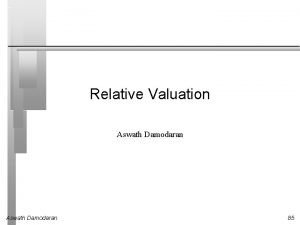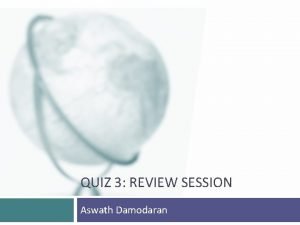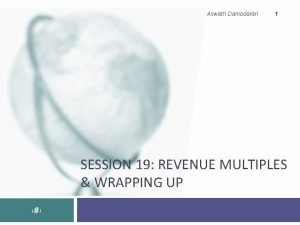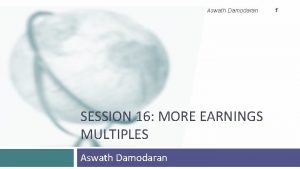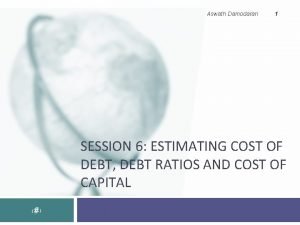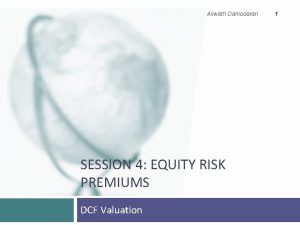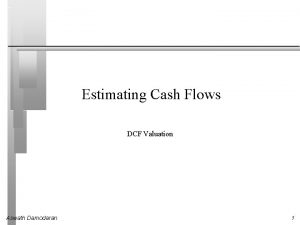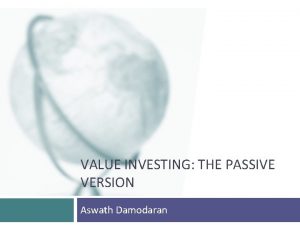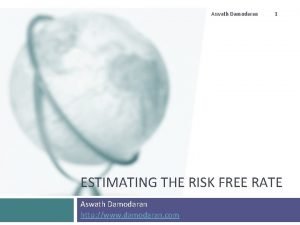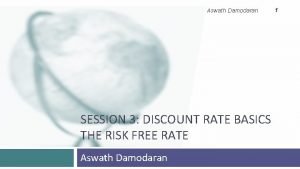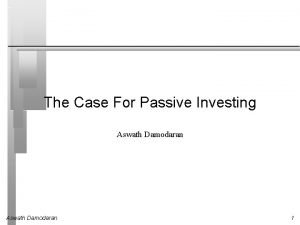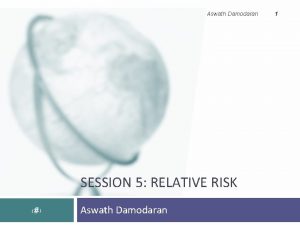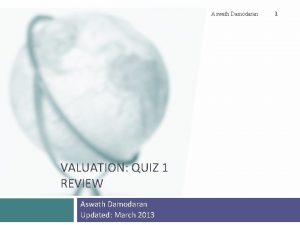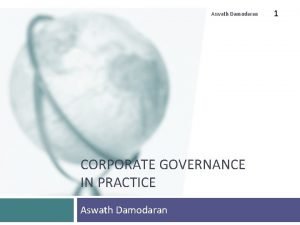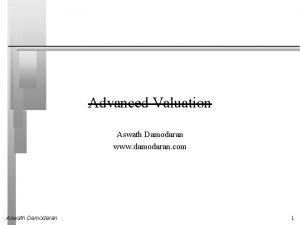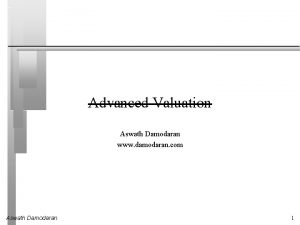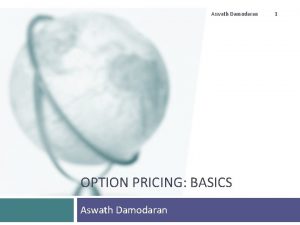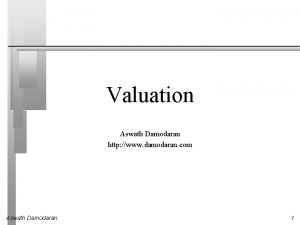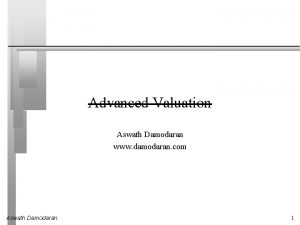Aswath Damodaran 1 SESSION 19 REVENUE MULTIPLES WRAPPING













- Slides: 13

Aswath Damodaran 1 SESSION 19: REVENUE MULTIPLES & WRAPPING UP ‹#›

Top Line Multiples 2 Aswath Damodaran 2

The EV/Sales Ratio - Drivers The EV/Sales Ratio Equation g = Growth rate in after-tax operating income for the first n years gn = Growth rate in after-tax operating income after n years forever (Stable growth rate) RIR Growth, Stable = Reinvestment rate in high growth and stable periods WACC = Weighted average cost of capital 3 Aswath Damodaran 3

The value of a brand name One of the benefits of having a well-known and respected brand name is that firms can charge higher prices for the same products, leading to higher profit margins and hence to higher revenue multiples. In general, the value of a brand name can be written as: � � � Value of brand name ={(V/S)b-(V/S)g }* Sales (V/S)b = Value of Firm/Sales ratio with the benefit of the brand name (V/S)g = Value of Firm/Sales ratio of the firm with the generic product 4 Aswath Damodaran 4

Valuing Brand Name Current Revenues = Length of high-growth period Reinvestment Rate = Operating Margin (after-tax) Sales/Capital (Turnover ratio) Return on capital (after-tax) Growth rate during period (g) = Cost of Capital during period = Stable Growth Period Growth rate in steady state = Return on capital = Reinvestment Rate = Cost of Capital = Value of Firm = Coca Cola $21, 962. 00 10 50% 15. 57% 1. 34 20. 84% 10. 42% 7. 65% With Cott Margins $21, 962. 00 10 50% 5. 28% 1. 34 7. 06% 3. 53% 7. 65% 4. 00% 7. 65% 52. 28% 7. 65% $79, 611. 25 4. 00% 7. 65% 52. 28% 7. 65% $15, 371. 24 Value of brand name = $79, 611 -$15, 371 = $64, 240 million 5 Aswath Damodaran 5

An Example: Let the market tell you what matters. . Social media in October 2013 Number of users Enterprise Company Market Cap value Revenues EBITDA Net Income (millions) EV/User EV/Revenue EV/EBITDA Facebook $173, 540. 00 $160, 090. 00 $7, 870. 00 $3, 930. 00 $1, 490. 00 1230. 00 $130. 15 20. 34 40. 74 Linkedin $23, 530. 00 $19, 980. 00 $1, 530. 00 $182. 00 $27. 00 277. 00 $72. 13 13. 06 109. 78 Pandora $7, 320. 00 $7, 150. 00 $655. 00 -$18. 00 -$29. 00 73. 40 $97. 41 10. 92 NA Groupon $6, 690. 00 $5, 880. 00 $2, 440. 00 $125. 00 -$95. 00 43. 00 $136. 74 2. 41 47. 04 Netflix $25, 900. 00 $25, 380. 00 $4, 370. 00 $277. 00 $112. 00 44. 00 $576. 82 5. 81 91. 62 Yelp $6, 200. 00 $5, 790. 00 $233. 00 $2. 40 -$10. 00 120. 00 $48. 25 24. 85 2412. 50 Open Table $1, 720. 00 $1, 500. 00 $190. 00 $63. 00 $33. 00 14. 00 $107. 14 7. 89 23. 81 Zynga $4, 200. 00 $2, 930. 00 $873. 00 $74. 00 -$37. 00 27. 00 $108. 52 3. 36 39. 59 Zillow $3, 070. 00 $2, 860. 00 $197. 00 -$13. 00 -$12. 45 34. 50 $82. 90 14. 52 NA Trulia $1, 140. 00 $1, 120. 00 $144. 00 -$6. 00 -$18. 00 54. 40 $20. 59 7. 78 NA Tripadvisor $13, 510. 00 $12, 860. 00 $945. 00 $311. 00 $205. 00 260. 00 $49. 46 13. 61 41. 35 Average $130. 01 11. 32 350. 80 Median $97. 41 10. 92 44. 20 6 Aswath Damodaran PE 116. 47 871. 48 NA NA 231. 25 NA 52. 12 NA NA NA 65. 90 267. 44 116. 47 6

Read the tea leaves: See what the market cares about Market Cap Enterprise value EBITDA Net Income Number of users (millions) Revenues 1. Enterprise value 0. 9998 1. Revenues 0. 8933 0. 8966 1. EBITDA 0. 9709 0. 9701 0. 8869 1. Net Income 0. 8978 0. 8971 0. 8466 0. 9716 1. Number of users (millions) 0. 9812 0. 9789 0. 8053 0. 9354 0. 8453 1. Market Cap Twitter had 240 million users at the time of its IPO. What price would you attach to the company? 7 Aswath Damodaran 7

Market Regressions Region Regression – January 2016 R Squared United States EV/Sales = 7. 42 + 2. 47 g+ 2. 96 Operating Margin – 2. 20 DFR- 9. 90 Tax rate 10. 1% Europe EV/Sales = -0. 89 + 9. 81 g+ 14. 63 Operating Margin + 14. 91 31. 4% DFR- 6. 10 Tax rate Japan EV/Sales = 2. 02 - 0. 48 g+ 8. 73 Operating Margin +2. 50 DFR 13. 6% - 5. 00 Tax rate Emerging Markets EV/Sales = 5. 66 + 5. 05 g+ 7. 86 Operating Margin -0. 55 DFR- 9. 80 Tax rate 14. 3% Australia, NZ EV/Sales = -0. 35 + 12. 03 g+ 5. 34 Operating Margin + 13. 95 36. 3% & Canada DFR- 2. 60 Tax rate Global EV/Sales =4. 73+ 3. 53 g+ 6. 92 Op. Margin + 3. 83 DFR- 9. 20 11. 5% Tax rate g =Expected Revenue Growth: Expected growth in revenues: Near term (2 or 5 years) ERP: ERP for country in which company is incorporated 8 Tax Rate: Effective tax rate in most recent year; Operating Margin: Operating Income/ Sales 8

Choosing Between the Multiples As presented in this section, there are dozens of multiples that can be potentially used to value an individual firm. In addition, relative valuation can be relative to a sector (or comparable firms) or to the entire market (using the regressions, for instance) Since there can be only one final estimate of value, there are three choices at this stage: � � � Use a simple average of the valuations obtained using a number of different multiples Use a weighted average of the valuations obtained using a nmber of different multiples Choose one of the multiples and base your valuation on that multiple 9 Aswath Damodaran 9

Picking one Multiple This is usually the best way to approach this issue. While a range of values can be obtained from a number of multiples, the “best estimate” value is obtained using one multiple. The multiple that is used can be chosen in one of two ways: � Use the multiple that best fits your objective. � Use the multiple that has the highest R-squared in the sector when regressed against fundamentals. � Use the multiple that seems to make the most sense for that sector, given how value is measured and created. 10 Aswath Damodaran 10

A More Intuitive Approach Managers in every sector tend to focus on specific variables when analyzing strategy and performance. The multiple used will generally reflect this focus. Consider three examples. � In retailing: The focus is usually on same store sales (turnover) and profit margins. � In financial services: The emphasis is usually on return on equity. � In technology: Growth is usually the dominant theme. PEG ratios were invented in this sector. 11 Aswath Damodaran 11

Relative versus Intrinsic Value Assume you value the same company doing both DCF and relative valuation correctly, should you get the same value? � � Yes No If not, how would you explain the difference? 12 Aswath Damodaran 12

Reviewing: The Four Steps to Understanding Multiples Define the multiple Check for consistency � Make sure that they are estimated uniformly � Describe the multiple Multiples have skewed distributions: The averages are seldom good indicators of typical multiples � Check for bias, if the multiple cannot be estimated � Analyze the multiple Identify the companion variable that drives the multiple � Examine the nature of the relationship � Apply the multiple 13 Aswath Damodaran 13
